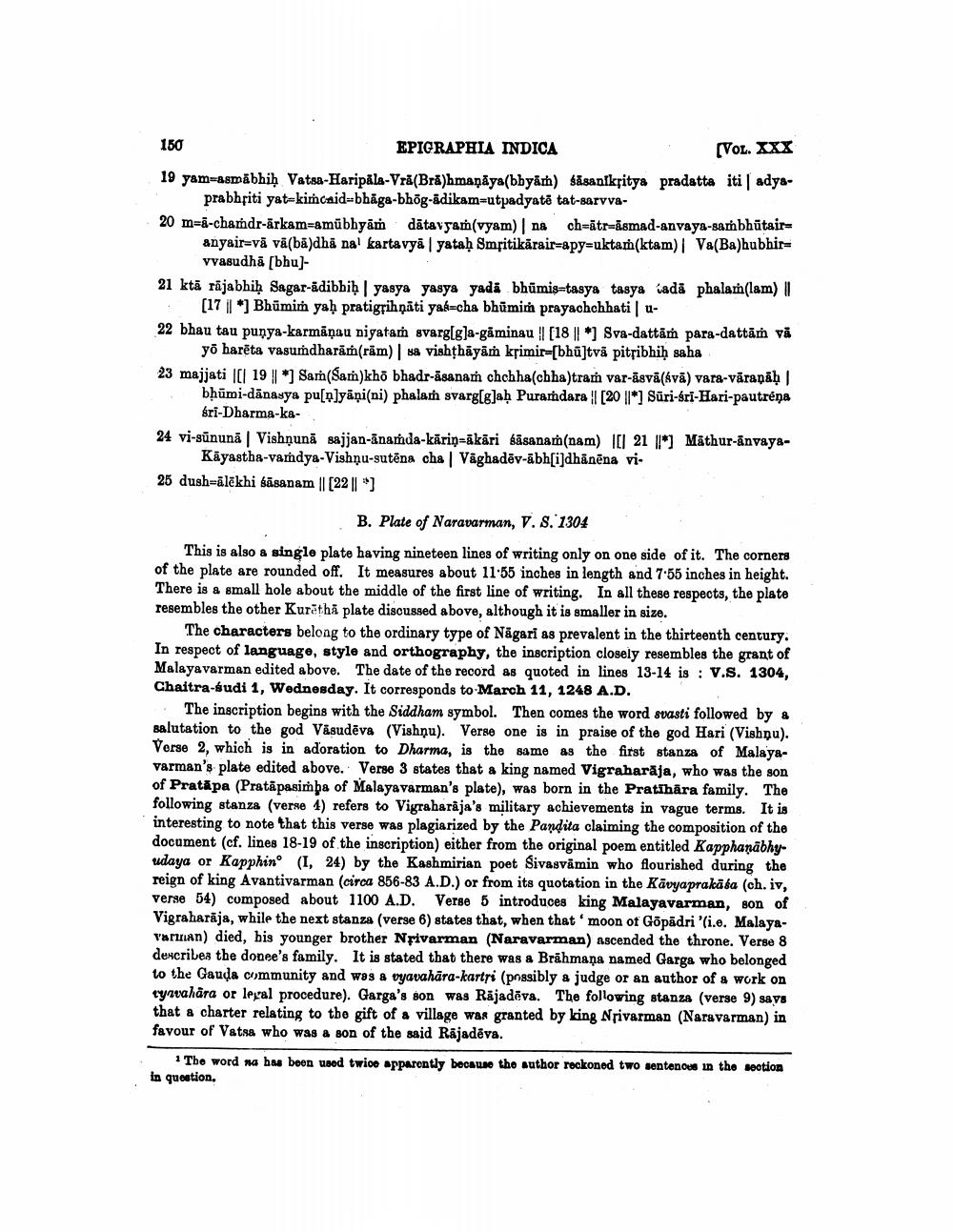________________
150 EPIGRAPHIA INDICA
(VOL. XXX 19 yam=asmäbhiḥ Vatsa-Haripäla-Vrä(Bra)hmaņāya(bbyän) såsanskritya pradatta iti adya
prabhfiti yat-kimcaid-bhāga-bhög-adikam=utpadyatë tat-sarvva20 m=ā-chamdr-ärkam=amūbhyaṁ dātavyam(vyam) na ch=ātr=āsmad-anvaya-sambhūtair
anyair=vā vä(ba)dha nal kartavyä | yataḥ Smritikārair=apy=uktam(ktam)| Va(Ba)hubhir
vvasudhā [bhu)21 ktā rājabhiḥ Sagar-adibbiḥ | yasya yasya yada bhūmis-tasya tasya iadā phalam(lam) |
(17 | *] Bhūmim yaḥ pratigpihņāti yak=cha bhūmim prayachchhati | 422 bhau tau punya-karmāņau niyataṁ svarg[g]a-gaminau !! [18 || *) Sva-dattāṁ para-dattām vå
yo harēta vasundharām(rām) sa vishthāyām ksimir-[bhū]tvá pitsibhiḥ saha 23 majjati ||| 19 l *) Sam(Saṁ)kho bhadr-āsanaṁ chchha(chha)tram var-āsvā(kvā) vara-vāraṇā)
bhumi-danasya pu[v]yāņi(ni) phalam svarg[g]ah Purandara I [20 II*] Suri-sri-Hari-pautréņa
Sri-Dharma-ka24 vi-sūnunā | Vishņunā sajjan-änamda-kāriņ=ākāri sasanam(nam) I[ 21 | Māthur-anvaya
Kāyastha-vamdya-Vishņu-sutēna cha | Våghadēv-ābh[i]dhānēna vi25 dush-ālēkhi sāsanam || [22 |)
B. Plate of Naravarman, V. S. 1304 This is also a single plate having nineteen lines of writing only on one side of it. The corners of the plate are rounded off. It measures about 11-55 inches in length and 7-55 inches in height. There is a small hole about the middle of the first line of writing. In all these respects, the plate resembles the other Kurathā plate discussed above, although it is smaller in size.
The characters belong to the ordinary type of Nägari as prevalent in the thirteenth century. In respect of language, style and orthography, the inscription closely resembles the grant of Malayavarman edited above. The date of the record as quoted in lines 13-14 is : V.S. 1304, Chaitra-sudi 1, Wednesday. It corresponds to March 11, 1248 A.D.
The inscription begins with the Siddham symbol. Then comes the word svasti followed by & Balutation to the god Väsudēva (Vishnu). Verse one is in praise of the god Hari (Vishnu). Vorse 2, which is in adoration to Dharma, is the same as the first stanza of Malayavarman's plate edited above. Verse 3 states that a king named Vigraharāja, who was the son of Pratápa (Pratapasimba of Malayavarman's plate), was born in the Prathāra family. The following stanza (verne 4) refers to Vigraharaja's military achievements in vague terms. It is interesting to note that this verse was plagiarized by the Pandita claiming the composition of the document (cf. lines 18-19 of the inscription) either from the original poem entitled Kapphanābhyudaya or Kapphino (I, 24) by the Kashmirian poet Sivasvimin who flourished during the reign of king Avantivarman (circa 856-83 A.D.) or from its quotation in the Kävyaprakasa (ch. iv, verse 54) composed about 1100 A.D. Verse 5 introduces king Malayavarman, son of Vigraharāja, while the next stanza (verse 6) states that, when that moon of Göpädri 'i.e. MalayaVaruan) died, his younger brother Nrivarman (Naravarman) ascended the throne. Verse 8 describes the donee's family. It is stated that there was a Brāhmaṇa named Garga who belonged to the Gauda community and was a vyavahara-karti (possibly a judge or an author of a work on yavahāra or legal procedure). Garga's son was Räjadēva. The following stanza (verse 9) says that a charter relating to the gift of a village was granted by king Nrivarman (Naravarman) in favour of Vatsa who was a son of the said Rajadēva.
1 The word na has been used twice apparently because the author reckoned two sentenous in the section in question.




